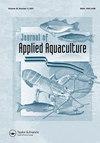Utilization of crystalline amino acids by Pacific white shrimp (Litopenaeus vannamei)
IF 0.8
Q3 FISHERIES
引用次数: 0
Abstract
ABSTRACT In view of the variability in recommendations for essential amino acid (EAA) and the use of amino acids supplements in shrimp diets, this study was designed to evaluate the efficacy of crystalline amino acids (CAA) in practical shrimp feeds. The basal diet was designed to contain 30% protein and 6% lipid. The primary protein source of the basal diet included: 5% fishmeal, 37% soybean, and 5% gelatin. The intact protein was incrementally reduced to produce diets with 28%, 26%, 24%, and 22% protein. In a second series of diets, CAA were supplemented to the reduced protein diets to return the diets to 30% crude protein. Thus, producing a series of diets containing 30% protein with 2%, 4%, 6%, and 8% crystalline amino acids. The trial was conducted twice to confirm results. Data within treatments for both trials were variable, resulting in limited statistical differences. From a biological standpoint, percentage weight gain (PWG) and mean final weight (MFW) appeared to decrease with intact protein level of the diet (R2 value [PWG], trial 1: 0.30, trial 2: 0.34, R2 value, [MFW] trial 1: 0.44, trial 2: 0.38). None of the diets with supplemented CAA appeared to have reached the same MFW or PWG as the basal diet. Another trial was run using a fishmeal-based diet (30% CP), which in theory should be replete in all essential amino acids, and a soybean meal-based diet at two different protein levels (30% and 35% CP). The soybean meal-based diets were supplemented with essential CAA in one set and only methionine in another to reach the same level as a percent protein, compared to the fishmeal-based diet. No significant differences were observed between the diets in terms of PWG. However, the fishmeal-based diet seemed to outperform most of the other diets in terms of protein retention efficiency. Based on the results of these trials, it is questionable whether CAA are sufficiently utilized by shrimp.凡纳滨对虾对晶体氨基酸的利用
本文章由计算机程序翻译,如有差异,请以英文原文为准。
求助全文
约1分钟内获得全文
求助全文
来源期刊

Journal of Applied Aquaculture
Environmental Science-Ecology
CiteScore
3.20
自引率
0.00%
发文量
38
期刊介绍:
The Journal of Applied Aquaculture is a platform for the sharing of practical information needed by researchers to meet the needs of investors, farm managers, extension agents and policy makers working to adapt aquaculture theory to achieve economic and food security objectives in the real world. The journal emphasizes multi-disciplinary research and case studies that propose financially and logistically viable solutions to observable problems.
 求助内容:
求助内容: 应助结果提醒方式:
应助结果提醒方式:


